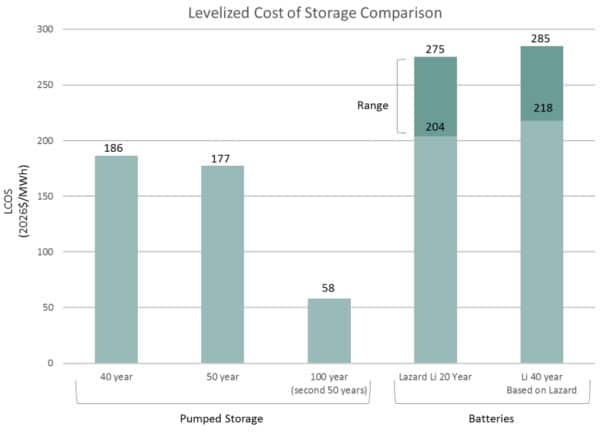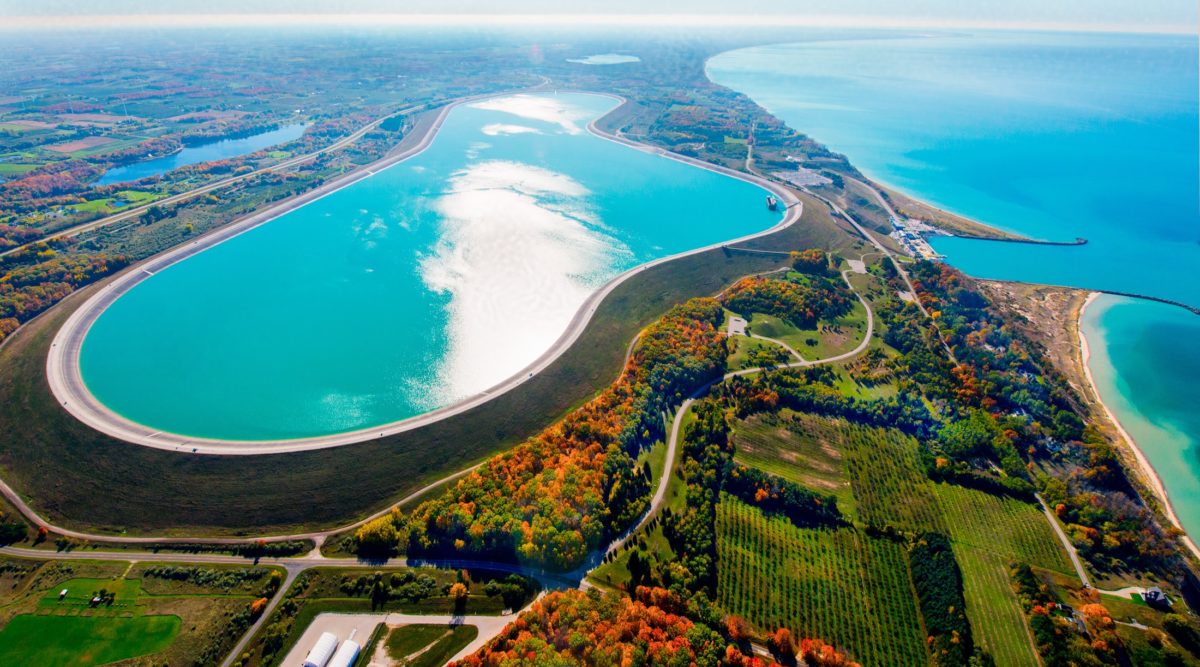Lazard’s well-known Levelized Cost of Storage analysis does not cover pumped hydro storage, and a pumped hydro cost estimate from the National Renewable Energy Laboratory is not expected until late this year, as a follow-up to an interim report.
Beating them to the punch is a report by UC San Diego professor David Victor and five co-authors, Pumped Energy Storage: Vital to California’s Renewable Energy Future. The report provides the following cost comparison between pumped hydro and battery storage:

The higher capital costs of pumped storage versus battery storage, says the report, are outweighed by the longer lifetime of pumped storage, giving it a lower levelized cost.
That projected lower levelized cost for pumped hydro storage, compared to battery storage, results largely from more favorable financing for pumped hydro.
For both technologies, the analysis assumes a 12% return on equity, but it models pumped hydro as being financed with a much greater portion of debt, and a much lower interest rate on its debt. Specifically, a pumped hydro project is modeled with 66% debt, versus 20% debt for battery storage; the pumped hydro interest rate is modeled at 5.52%, versus 8% interest for battery storage. The modeled interest rate is based on discussions with pumped storage developers.
As for battery costs, the report states that its analysis largely used Lazard’s assumptions, and that its battery results “correlate well” with the low end of Lazard’s results. Specifically, in the fourth bar of the graph above, showing “Lazard Li 20 year” battery storage costs, the low end of the range—$204 per MWh (for 2026)—matches the low end of Lazard’s range of cost estimates for batteries serving wholesale markets (based on 2018 product/component delivery). (Lazard also shows a significantly lower cost range—$108 to $140 per MWh—for storage used in utility-scale solar + storage.)
The report’s publisher, the San Diego County Water Authority, and the City of San Diego jointly hold a preliminary permit for a 500 MW (4000 MWh) pumped hydro storage project at the San Vincente Dam and Reservoir, owned by the City of San Diego. A fact sheet says that the project would involve a new upper reservoir above the existing San Vicente Reservoir, with a tunnel connecting the two reservoirs, plus an underground powerhouse.
The report calls for state-backed support for early pumped hydro storage projects “that would jump-start investment in this proven technology.” Such support, it adds, “can demonstrate viable business models and investment strategies that will pave the way for more private sector-led projects in the future.”
The methods and assumptions of the Pumped Energy Storage report are explained in an appendix to the report. Five co-authors joined Dr. David Victor in preparing the report: Kevin Davis and Scott Flake, both with Black & Veatch; independent consultant Thomas Haag; Gary Bousquet with the San Diego County Water Authority; and Lan Wiborg with the City of San Diego.
This content is protected by copyright and may not be reused. If you want to cooperate with us and would like to reuse some of our content, please contact: editors@pv-magazine.com.








Why not add floating Solar to the project.
With Li battery technology becoming a multi-billion dollar industry, major improvements will occur in all aspects of battery storage. And they will be coming fast. Further, projecting anything technology-related forty years into the future is just plain silly with our ever-accelerating rate of advance.
Are faultlines and earthquake prone areas taken into consideration? A raised reservoir could break underneath possibly causing the water levels to drop into a sinkhole. Just wondering how rare this would be. Evaporation may be a bigger issue and greater possibility.
Mr. Thompson, we are presently doing 50 and 100 year refurbishments on hydro projects, they do indeed last that long. Batteries have limited numbers of cycles, at best with low cycles per week 20 years right now, marginal improvements might occur. This is about degradation of the electrolytes as the number of cycles increases, You simply cannot repeal the physics governing reversible electrochemistry. Other battery types might perform better in some situations. Big problem: How do you dispose of or recycle large amounts of toxic used up electrochemicals?
jw, you raise a good question. Reservoir induced earthquakes have indeed occurred. At this point we do have the geological knowledge to be able to identify where such things might happen and choose not to build there. The profession has been all over this one with constantly improving knowledge for more than 50 years. You have not heard much about this happening in the general press for the reason that the industry is careful about this so for the most part it does not happen. Not perfect, but careful. In California, for instance, a high quality site-specific seismicity study and integration of the results of that study into the design is required by appropriate government agencies before they will issue construction permits. Same for the Federal Energy Regulatory Commission on non-federal hydropower projects.
Pumped hydro works, Northfield Mountain is a great example – built in 1972 it is capable of powering more than 1 million homes for up to 7.5 hours each day and currently in service.
https://www.wbur.org/bostonomix/2016/12/02/northfield-mountain-hydroelectric-station
We need more pumped storage – where the terrain is agreeable and water resources are available. The environmental impact is so much less than the impact of currently available batteries, and the equipment doesn’t wear out in 20 years or less. It pairs very well with solar to provide power when the sun isn’t shining.
Lots of assumptions about batteries that are subject to dramatic change. Notice references to ‘currently available batteries’ and similar.
There are major physics breakthroughs coming in batteries. The battery data used for the comparisons above will go out the window. They won’t be toxic, either, and can be recycled.
I don’t choose to challenge the estimates for the pumped storage itself, but I would point out that a major earthquake is likely to dump that water on anything located downhill, all of a sudden. I suggest using UHPC to mitigate the danger.